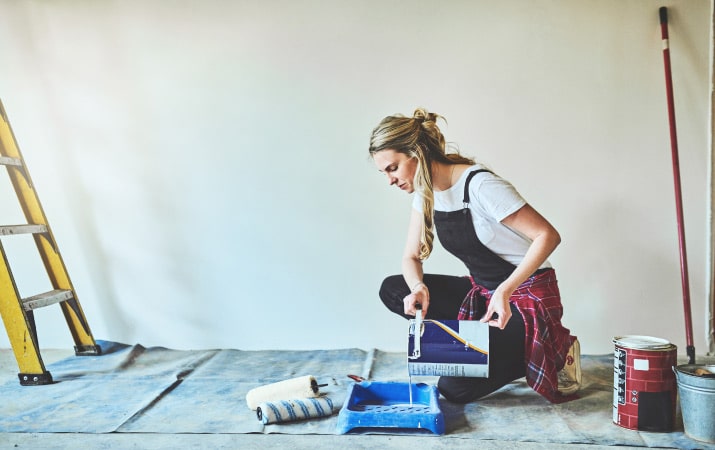
Ready to fix up your fixer-upper house? 6 tips to go about it
Remodeling and Renovation Tips
With 2020 vacations cancelled and weekends at home stretching into the winter, John Acevedo did what so many people did during the first year of the COVID-19 pandemic: He got out his tools and tackled a renovation. “The virus put an end to our travel plans,” said John, who lives with his wife in Alberta, Canada, “so we decided to redo our garage as a workout space.” Today, the couple’s man cave/she shed is outfitted with a weight-training machine, a stairclimber, and other fitness needs.
Feel a lot like the Acevedos and ready to go full HGTV? This article’s for you. We’ve outlined important tips to keep in mind before you tear down that wall or update the kitchen — or, like a few brave souls, take on an entire fixer-upper house re-do.
First, make a plan
What is the first thing to do when renovating a house? When it comes to making long-term changes to your home, you should always start with a plan. And like any good strategy, your plan should include the supplies you’ll need, a timetable, and your step-by-step process. What’s your home renovation budget? How much time do you have to complete the project? Where will you keep your belongings in the meantime?
For Lucas Mast, renovation fever started five years ago when he and his wife bought their home just outside San Francisco, California. It wasn’t necessarily a fixer-upper house; it was comfortable and in good shape. But it needed some TLC here and there to make it their dream home.
Like many DIYers, the Masts conducted a somewhat slo-mo remodel in their first few years, dabbling here and there on projects. But when the pandemic lingered into the fall, their work accelerated into a full re-do of their garage — which made it even more essential to have a solid plan. “Especially with the decluttering we needed to do, we had to have a strategy for getting all our things out so we could do the work,” he said.
So how did they get from the planning stage to the finished home gym? They asked an expert for guidance: Berkshire Hathaway agent Joe Klemmer. The Philadelphia area–based pro knows how to DIY. “My wife and I have done the ‘This Old House’ thing a number of times in 30 years of marriage,” he said. “We’ve bought and renovated and lived in a number of them. Going back into my teens, my uncle taught me how to do minor repairs in a duplex he and my mother inherited from my grandparents, so I’ve been doing this for a long time.”

Then, get educated
One of Joe’s big pieces of advice? Make sure you’re in compliance with local codes. That means learning how to renovate a home the safest and most correct way. You can get fined if you don’t follow the rules. But more importantly, if you don’t know what you're doing, you risk injury or unsafe conditions. “An issue I see with new investors is they’ll take a week-long ‘How to Flip Houses’ course, but they don’t learn anything about codes,” Joe said.
One of the benefits of our digital age is the endless breadth of knowledge available, including a hefty helping of how-to videos. Home improvement stores also offer classes for weekend warriors; Joe highly recommends checking into that option before you start tearing up tile. “They have a lot of resources available to help you get your feet wet if you want to start doing this,” Joe said. “The classes can be helpful if you’re buying or renovating.”
| Did you know? Certain jurisdictions have code-enforcement officers who actually drive around and look for people who are renovating but haven’t requested the appropriate permits. |
Don’t hesitate to call in the pros
This is key, according to experts. Beware of biting off more than you can do. That’s especially critical when you’re dealing with electrical systems. “You can really get yourself in trouble,” said Joe. “From starting a fire to getting yourself electrocuted, there are dangers if you don’t know what you’re doing.” Sure, the consequences of a plumbing mishap, while certainly not fun, don’t carry the same destructive potential. But, suffice it to say, it’s always wise to factor into your home renovation budget the cost of a professional for the more complicated parts of your revamp.
And if you’re doing a full house renovation, tearing out drywall and reconfiguring walls, Joe says it’s a good opportunity to rewire the house while you’ve got the wires exposed. “Have a bona fide electrician come in to do a whole house rewire,” he said.
For Lucas, there wasn’t any electrical work involved in the garage upgrade. But still, humility is important: “We cleared everything out, got it into our PODS container, and then had somebody come in and do the rest of the work,” said Lucas. “I know my limitations.”

Prioritize your rehab activities
Taking into account your time frame and budget, devise a plan based on what makes the most sense in terms of sequencing. If you’re overhauling your upstairs bedrooms and baths, for instance, think about which room you want finished first. If your entire family is camping out in the living room for the duration, Mom and Dad probably want to decamp ASAP. That means the primary bath needs to be first — because who wants to traipse downstairs and share the powder room with the kids unless absolutely necessary, right? Think logically and consider your sanity as you’re working with your contractor or planning your DIY project.
“We started with putting a heater in the garage,” said John. “Then it was the domino effect.” The original plan to lay down rubber mats morphed into finishing the floors. So, naturally, the family needed a place to stash their belongings until the garage was finished — an essential part of planning.
If your reno is outdoors, the same principles of planning apply. Paving your driveway? Make a plan for where you’ll park your car, particularly if the weather is a factor.
For smaller DIY projects like the Acevedos’, portable storage, like PODS storage containers, allows you to make room for the work while keeping your things nearby. For larger house-wide projects, furniture and other belongings can be kept in a secure storage facility — also offered by PODS — during renovations.
“With the PODS storage container, we had the convenience of having our stuff right there in our driveway,” John said. “Especially because it was the middle of winter, I had all my stuff — including my backpack blower for the snow — within easy reach.”
If your reno is outdoors, the same principles of planning apply. Paving your driveway? Make a plan for where you’ll park your car, particularly if the weather is a factor. The Masts, who live in a cul-de-sac at the top of a hill, started with projects that culminated with their garage redo: “We focused on the outdoor spaces and worked our way up,” said Lucas, “starting with a fence, and then we redid the driveway and some stonework with a retaining wall, put on a new roof, and several other things.”
The last step was redoing the garage. “We really wanted to make it a livable space,” Lucas said. “We put on a new garage door, epoxied the floor, and added shelving and storage units. Now we have a workout space.”

Get the most bang for your buck
For a super-easy job that provides a solid return on your investment, start with a fresh coat of paint. It’s not terribly expensive or arduous to change the color of a room. And if you know what you’re doing (see above: get educated), your DIY facelift can work wonders. Your fixer-upper before-and-after photos will likely look just as good as the pros’.
Kitchens and baths are also good opportunities for ROI. “Simply refurbishing cabinets will upgrade your space without breaking the bank,” Joe said. “Similarly, in a bathroom, maybe put in new tile or a new toilet and vanity to upgrade the room without going through a $15K renovation — you’ll probably end up spending a few grand instead.”
Hardwood floors are in high demand these days, too, so they provide a good return. But if you’re exposing or refinishing floors in an older home, Joe suggests looking for telltale signs of animal damage — from cats, in particular. Scratches or stains might boost your cost, so be prepared.
...building a relationship with a local bank has its advantages when you’re considering financing for home renovation plans.
Get to know your local lenders
Just like working with a local real estate agent and contractor, building a relationship with a local bank has its advantages when you’re considering financing for home renovation plans. For starters, Joe says, the lender may be able to help you find a contractor they’ve worked with and trust to help you stay on budget, which, of course, makes the bank more likely to approve your loan.
Can you add renovations to a mortgage when purchasing? According to Joe, you may be able to. “They know the house is going to be worth more when you’re finished,” Joe added, “so they may be willing to roll the home renovation loan into your mortgage.”

Give yourself well-deserved credit
Is sweat equity worthwhile? In a word, yes — on two levels: “You get the personal satisfaction of saying, ‘Hey, I did this work and we fixed this up and enjoy living in it,” Joe said. “And you end up with a home you may choose to keep and enjoy, or use as a rental or sell and earn a profit.”
That sense of accomplishment also applies to smaller DIY projects. “We’re super excited,” said Lucas. “Our garage looks great! It’s still a storage space with a pantry area and a few other things, but we have our bikes, free weights, stationary bike, and other sports equipment. And we have room for a golf cart now. We love it.”
Want more tips on how to make your home makeover a home run? From adding curb appeal to adding square footage, the PODS blog has it all!
Shannon Jacobs is a Tampa-based freelance writer and frequent contributor to the PODS blog. She has lived in Atlanta, the Berkshires, and Nashville, but always returns to the warmth of Florida’s Gulf Coast.
Related Articles
Comments
Leave a Comment
Your email address will not be published. Required fields are marked *
